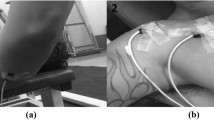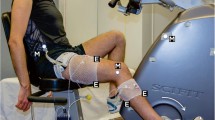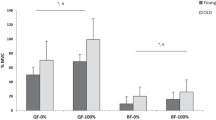Abstract
The goal of this paper was to investigate the amplitude and sub-100 Hz frequency content of surface electromyography (EMG) signals obtained from agonist, antagonist and synergist muscles during a heel-raise task sustained to failure. Twenty-two healthy adults, 14 men and 8 women participated in the study. Surface EMG data from the raising and lowering phases of the movement were studied in the time (EMG amplitude) and frequency (wavelet transform) domains. For the raising phase, we found a significant increase in the EMG amplitude of all muscles studied throughout the task (P < 0.02); however, for the lowering phase, we found a decrease in overall muscle activation for the medial gastrocnemius and tibialis anterior. Additionally, we found higher 13–30 and 30–50 Hz normalized power during the raising phase for the triceps surae prior to task failure and at task failure compared with the beginning and midway of the task (P < 0.05); during the lowering phase, however, we found higher normalized power from 30 to 50 Hz for the triceps surae (P < 0.01) and higher 13–30 Hz normalized power for the tibialis anterior (P < 0.01) at task failure compared with the beginning and midway of the task. Finally, we showed that a dynamic task performed until failure can induce different activation strategies for agonist, antagonist and synergist muscles, and that the frequency content below 100 Hz contains useful information about the neural activation of these muscles in relation to task failure that is not evident from the EMG amplitude.





Similar content being viewed by others
References
Addison PS (2002) The illustrated wavelet transform handbook. Taylor and Francis Group, New York
Balestra G, Frassinelli S, Knaflitz M, Molinari F (2001) Time–frequency analysis of surface myoelectric signals during athletic movement. IEEE Eng Med Biol Mag 20:106–115
Barry BK, Enoka RM (2007) The neurobiology of muscle fatigue: 15 years later. Integr Comp Biol 47:465–473
Bonato P, Gagliati G, Knaflitz M (1996) Analysis of myoelectric signals recorded during dynamic contractions: a time–frequency approach to assessing muscle fatigue. IEEE Eng Med Biol Mag 15:102–111
Bonato P, Cheng MSS, Gonzalez-Cueto J, Leardini A, O’Connor J, Roy SH (2001) EMG-based measures of fatigue during a repetitive squat exercise: assessment of dynamic conditions can provide information about compensatory muscle function in ACL patients. IEEE Eng Med Biol Mag 20:133–143
Brown P (2000) Cortical drives to human muscle: the Piper and related rhythms. Prog Neurobiol 60:97–108
Christou EA, Shinohara M, Enoka RM (2003) Fluctuations in acceleration during voluntary contractions lead to greater impairment of movement accuracy in old adults. J Appl Physiol 95(1):373–384
Christou EA, Rudroff T, Enoka JA, Meyer F, Enoka RM (2007) Discharge rate during low-force isometric contractions influences motor unit coherence below 15 Hz but not motor unit synchronization. Exp Brain Res 178:285–295
DeLuca CJ (1997) The use of surface electromyography in biomechanics. J Appl Biomech 13:135–163
Enoka RM, Duchateau J (2008) Muscle fatigue: what, why and how it influences muscle function. J Physiol 586:11–23
Enoka RM, Stuart DG (1992) Neurobiology of muscle fatigue. J Appl Physiol 72:1631–1648
Farina D (2006) Interpretation of the surface electromyogram in dynamic contractions. Exerc Sport Sci Rev 34(3):121–127
Farina D, Merletti R, Enoka RM (2004) The extraction of neural strategies from the surface EMG. J Appl Physiol 96:1486–1495
Farmer SF, Halliday DM, Conway BA, Stephens JA, Rosenberg JR (1997) A review of recent applications of cross-correlation methodologies to human motor unit recording. J Neurosci Methods 74:175–187
Felici F (2006) Neuromuscular responses to exercise investigated through surface EMG. J Electromyogr Kinesiol 16:578–585
Gabriel DA, Basford JR, Na KN (2001) Neural adaptations to fatigue: implications for muscle strength and training. Med Sci Sports Exerc 33:1354–1360
Galambos R, Makeig S, Talmachoff PJ (1981) A 40-Hz auditory potential recorded from the human scalp. Proc Natl Acad Sci USA 78(4):2643–2647
Gandevia SC (2001) Spinal and supraspinal factors in human muscle fatigue. Physiol Rev 81:1725–1789
Garland SJ, Enoka RM, Serrano LP, Robinson GA (1994) Behavior of motor units in human biceps brachii during a submaximal fatiguing contraction. J Appl Physiol 76:2411–2419
Grinsted A, Moore JC, Jevrejeva S (2004) Application of the cross wavelet transform and wavelet coherence to geophysical time series. Nonlinear Processes Geophys 11:561–566
Haber M, Golan E, Azoulay L, Kahn SR, Shrier I (2004) Reliability of a device measuring triceps surae muscle fatigability. Br J Sports Med 38:163–167
Hassani A, Patikas D, Bassa E, Hatzikotoulas K, Kellis E, Kotzamanidis C (2006) Agonist and antagonist muscle activation during maximal and submaximal isokinetic fatigue tests of the knee extensors. J Electromyogr Kinesiol 16:661–668
Hermens HJ, Freriks B, Disselhorst-Klug C, Rau G (2000) Development of recommendations for SEMG sensors and sensor placement procedures. J Electromyogr Kinesiol 10:361–374
Hostens L, Seghers J, Spaepen A, Ramon H (2004) Validation of the wavelet spectral estimation technique in biceps brachii and brachioradialis fatigue assessment during prolonged low-level static and dynamic contractions. J Electromyogr Kinesiol 14:205–215
Hunter SK, Ryan DL, Ortega JD, Enoka EM (2002) Task differences with the same load torque alter the endurance time of submaximal fatiguing contractions in humans. J Neurophysiol 88:3087–3096
Hunter SK, Duchateau J, Enoka RM (2004) Muscle fatigue and the mechanisms of task failure. Exerc Sport Sci Rev 32:44–49
Hunter SK, Yoon T, Farinella J, Griffith EE, Ng AV (2008) Time to task failure and muscle activation vary with load type for a submaximal fatiguing contraction with the lower leg. J Appl Physiol 105:463–472
Karlsson S, Yu J, Akay M (2000) Time–frequency analysis of myoelectric signals during dynamic contractions: a comparative study. IEEE Trans Biomed Eng 47:228–238
Kouzaki M, Shinohara M (2006) The frequency of alternate muscle activity is associated with the attenuation in muscle fatigue. J Appl Physiol 101:715–720
Kouzaki M, Shinohara M, Masani K, Fukunaga T (2004) Force fluctuations are modulated by alternate muscle activity of knee extensor synergists during low-level sustained contraction. J Appl Physiol 97:2121–2131
Lévénez M, Kotzamanidis C, Carpentier A, Duchateau J (2005) Spinal reflexes and coactivation of ankle muscles during a submaximal fatiguing contraction. J Appl Physiol 99(3):1182–1188
Lowery MM, Myers LJ, Erim Z (2007) Coherence between motor unit discharges in response to shared neural inputs. J Neurosci Methods 163:384–391
Maluf KS, Shinohara M, Stephenson JL, Enoka RM (2005) Muscle activation and time to task failure differ with load type and contraction intensity for a human hand muscle. Exp Brain Res 167:165–177
Moritz CT, Christou EA, Meyer FG, Enoka RM (2005) Coherence at 16–32 Hz can be caused by short-term synchrony of motor units. J Neurophysiol 94:105–118
Mottram CJ, Hunter SK, Rochette L, Anderson LK, Enoka RM (2006) Time to task failure varies with the gain of the feedback signal for women, but not for men. Exp Brain Res 174:575–587
Myers LJ, Lowery M, O’Malley M, Vaughan CL, Heneghan C, St Clair Gibson A, Harley YX, Sreenivasan R (2003) Rectification and non-linear pre-processing of EMG signals for cortico-muscular analysis. J Neurosci Methods 124:157–165
Neto OP, Christou EA (2010) Rectification of the EMG signal impairs the identification of oscillatory input to the muscle. J Neurophysiol 103:1093–1103
Neto OP, Magini M (2008) Electromiographic and kinematic characteristics of Kung Fu Yau-Man palm strike. J Electromyogr Kinesiol 18:1047–1052
Neto OP, Marzullo ACD (2009) Wavelet transform analysis of electromyography Kung Fu strikes data. J Sports Sci Med 8(CSSI 3):25–28
Neto OP, Baweja HS, Christou EA (2010) Increased voluntary drive is associated with changes in the common oscillations from 13–60 Hz of interference but not rectified electromyography. Muscle Nerve (in press)
Pasquet B, Carpentier A, Duchateau J (2006) Specific modulation of motor unit discharge for a similar change in fascicle length during shortening and lengthening contractions in humans. J Physiol 577(2):753–765
Potvin JR (1997) Effects of muscle kinematics on surface EMG amplitude and frequency during fatiguing dynamic contractions. J Appl Physiol 82:144–151
Psek JA, Cafarelli E (1993) Behavior of coactive muscles during fatigue. J Appl Physiol 74:170–175
Rothmuller C, Cafarelli E (1995) Effect of vibration on antagonist muscle coactivation during progressive fatigue in humans. J Physiol 485:857–864
Rudroff T, Barry BK, Stone AL, Barry CJ, Enoka RM (2007) Accessory muscle activity contributes to the variation in time to task failure for different arm postures and loads. J Appl Physiol 102(3):1000–1006
Salenius S, Salmelin R, Neuper C, Pfurtscheller G, Hari R (1996) Human cortical 40 Hz rhythm is closely related to EMG rhythmicity. Neurosci Lett 213:75–78
Sirin AV, Patla AE (1987) Myoelectric changes in the triceps surae muscles under sustained contractions. Evidence for synergism. Eur J Appl Physiol 56:238–244
So RCH, Ng JKF, Lam RWK, Lo CKK, Ng GYF (2009) EMG wavelet analysis of quadriceps muscle during repeated knee extension movement. Med Sci Sports Exerc 41:788–796
Søgaard K, Christensen H, Jensen BR, Finsen L, Sjøgaard G (1996) Motor control and kinetics during low level concentric and eccentric contractions in man. Electroenceph Clin Neurophysiol 101:453–460
Svantesson U, Osterberg U, Thomee R, Grimby G (1998a) Muscle fatigue in a standing heel-rise test. Scand J Rehab Med 30:67–72
Svantesson U, Osterberg U, Thomee R, Peeters M, Grimby G (1998b) Fatigue during repeated eccentric–concentric and pure concentric muscle actions of the plantar flexors. Clin Biomech 13(4–5):336–343
Taylor JL, Gandevia SC (2008) A comparison of central aspects of fatigue in submaximal and maximal voluntary contractions. J Appl Physiol 104:542–550
Torrence C, Compo GP (1998) A practical guide to wavelet analysis. B Am Meteorol Soc 79:61–78
Weir JP, Keefe DA, Eaton JF, Augustine RT, Tobin DM (1998) Effect of fatigue on hamstring coactivation during isokinetic knee extensions. Eur J Appl Physiol Occup Physiol 78:555–559
Zazula D, Karlsson S, Doncarli C (2004) Advanced signal processing techniques. In: Merletti R, Parker P (eds) Electromyography: physiology, engineering, and noninvasive applications. Wiley and sons, New Jersey, pp 259–304
Acknowledgments
This work was supported by National Institute on Aging Grant R01AG-031769 to E.A. Christou. The authors would like to thank Prof. Evangelos Christou for valuable suggestions.
Author information
Authors and Affiliations
Corresponding author
Additional information
Communicated by Susan Ward.
Rights and permissions
About this article
Cite this article
Pereira, R., Schettino, L., Machado, M. et al. Task failure during standing heel raises is associated with increased power from 13 to 50 Hz in the activation of triceps surae. Eur J Appl Physiol 110, 255–265 (2010). https://doi.org/10.1007/s00421-010-1498-3
Accepted:
Published:
Issue Date:
DOI: https://doi.org/10.1007/s00421-010-1498-3




